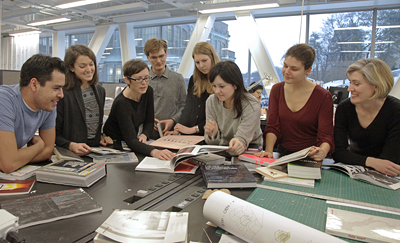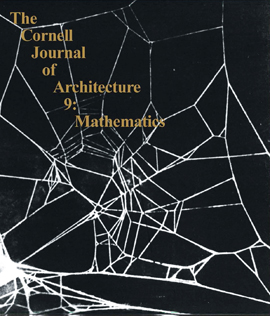Architecture journal explores uncertainty, idealism in math
By Daniel Aloi

The Cornell Journal of Architecture looks at architecture’s enduring love affair with another discipline in its new issue, “Mathematics.”
Issue No. 9 of the journal approaches that relationship from two angles, faculty editor Caroline O’Donnell said – “from the traditional point of view, in which proportion, order and symmetry are the basis of architectural form; and from the contemporary perspective, as architecture opens up to computation, and with it, uncertainty, chaos and unpredictability.”
Architects, artists and writers contributed their various perspectives to the issue, edited by a team of 17 journal editors, all of whom were B.Arch. and M.Arch. students.
O’Donnell is the Richard Meier Assistant Professor of Architecture in the College of Architecture, Art and Planning (AAP). All of the editors participated in one or both semesters of her seminar Sojourns: Rethinking the Publication, where they reviewed contemporary and historic journals and publications, and analyzed their themes, design and content.
The previous issues of the journal also provided some useful examples during the planning stages. “We talked about what was successful in past issues, [such as] for example in Issue 8, the fact that the image appeared on the page at the precise moment that it was talked about in the text; or the balance between image and text in some of the early issues,” she said.
The editors handle all aspects of publication, from correspondence with contributors to soliciting permissions for article reprints and artwork, and layout and design. Contributors were given feedback last fall from a blind peer review and from the student editors.
“It’s like a theory class where you actually get to change the text,” O’Donnell said of the planning and publication process. “It’s also about understanding how writing works – it’s a process, like design is a process.”
The journal is a hands-on experience for the students, she said. “They’re very enthusiastic, as they should be – they’re really producing something that will live forever. And they’re very committed; they have to be – it’s a huge amount of work.”
Interviews in the new issue include “Error and Generation,” a discussion with artist James Siena ’79; “A Conversation on Uncertainty” with Milstein Hall project leader Shohei Shigematsu, a partner with Rem Koolhaas in OMA; and “A Strategy of Posing Questions” with former AAP dean Anthony Vidler, recently dean of the school of architecture at Cooper Union.
“Dinner with Friends” is a transcript of dinner conversation between professors Jerry Wells and Arthur Ovaska and several editors, changing topics with each math-themed course on the menu, such as “Mobius Strip Steak” and “Apple Pi.”

Cornell architecture faculty contributors also include Jenny Sabin on materials and the impurities that arise in their making; Mark Morris on scale; Dana Čupková and Kevin Pratt on fuzziness; Archie B. Mackenzie on games; Val Warke on “The Grotesque Body and the Post-Humanist Subject”; and O’Donnell, who submitted “The Deformations of Francesco De Marchi” under a pseudonym to preserve the anonymity of the peer review.
Also contributing: recent visiting faculty in architecture Mario Carpo, Bernard Cache and Gisela Baurmann; and Cornell faculty members Daina Taimina, mathematics; and Gang Chen, earth and atmospheric sciences. Contributors-at-large included Francois Roche, Tom Fecht, Joseph Choma and Michael Young.
“We always ask ourselves what makes us the Cornell Journal of Architecture, as opposed to any other journal,” O’Donnell said. “‘Mathematics’ had the ability to encompass a range of work while still being bracketed on one hand by Cornell’s history and on the other, its future trajectory.”
The journal was founded in 1981, while Wells was architecture department chair. Following an eight-year hiatus, students resumed work on the publication in 2009, resulting in Issue No. 8 in January 2011.
The new issue will be launched with an event April 5 at 6:30 p.m. in Milstein Hall.
Media Contact
Get Cornell news delivered right to your inbox.
Subscribe